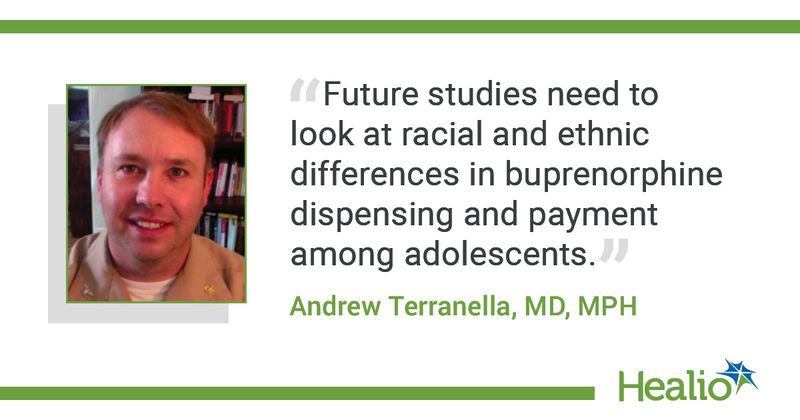Out-of-pocket costs for buprenorphine fall but price remains barrier for many
Key takeaways:
- Mean out-of-pocket costs for buprenorphine fell more 57% in 5 years.
- Costs were around 24 times higher with commercial payers and 119 times higher for self-pay compared with Medicaid.
Although mean daily out-of-pocket costs for buprenorphine — a medication for opioid use disorder — fell from 2015 to 2020 in the United States, cost remains a barrier for many people, according to findings published in JAMA Pediatrics.
Mean out-of-pocket cost for the medication declined almost 60% over the course of the study but were around 24 times higher for people with commercial insurance and 119 times higher for people with self-pay insurance compared with Medicaid, the researchers reported.

Adolescents and young adults are among those most affected by the overdose epidemic, one of the researchers noted.
“Buprenorphine is vastly underutilized in adolescents and young adults despite its proven efficacy and despite recommendations for use by professional organizations,” Andrew Terranella, MD, MPH, a researcher in the CDC’s Division of Overdose Prevention, told Healio.
“We know that insurance coverage and out-of-pocket costs can be an important factor in whether patients access care, and previous studies in adults have found out-of-pocket costs and insurance coverage to influence access to and retention in treatment for opioid use disorder (OUD),” Terranella said. “We wanted to look at the landscape of payers and out-of-pocket costs for buprenorphine prescriptions dispensed to youth.”
Terranella and colleagues assessed data from the IQVIA Longitudinal Prescription Data, which captures 93% of all prescriptions dispensed in the U.S. from 48,900 retail pharmacies. They catalogued average daily cost per prescription of buprenorphine for each prescription dispensed to youth aged 12 to 19 years and whether they had commercial insurance, Medicaid or self-pay insurance.
“We looked at trends in payer and cost over time and by age, sex, region and urbanicity to describe the overall payment landscape in the U.S. which can help us think about ways to break down barriers to care,” Terranella said.
From a sample of 221,342 buprenorphine prescriptions dispensed for youths from 2015 to 2020, the authors found that mean daily out-of-pocket costs decreased 57.6% from $4.03 in 2015 to $1.71 in 2020.
Daily out-of-pockets costs were lowest for people with Medicaid, declining from 9 cents to 7 cents over the study period. They were highest for self-pay prescriptions (declining from $9.80 to $8.33) and those paid by assistance ($7.88, $5.81). Daily out-of-pocket costs for commercially insured people declined from $3.80 to $1.68.
Patients in the South, in rural areas of the U.S. and younger adolescents saw the largest disparities in cost, the researchers found.
“We were heartened to see overall out-of-pocket costs for buprenorphine have come down in recent years,” Terranella said. “This was largely driven by increases in the proportion of prescriptions paid by Medicaid relative to third-party payers. However, a somewhat surprising result was the regional variation, with higher out-of-pocket costs found in the South and fewer prescriptions paid for by Medicaid. This might be related to differences in Medicaid eligibility in those regions.”
The study has implications for policy, Terranella added.
“Improving access to insurance coverage that includes medications for opioid use disorder could decrease [the] cost burden for adolescents and their families, thus reducing or eliminating cost as a barrier to treatment,” Terranella said. “For clinicians, this study highlights the fact that while cost remains a barrier for many patients, out-of-pocket costs for most patients are low.”
Terranella said he would like to see more research conducted on clinician education, providers’ willingness to prescribe buprenorphine to adolescents and stigma.
“Future studies need to look at racial and ethnic differences in buprenorphine dispensing and payment among adolescents,” Terranella said. “We also should explore best practices to link adolescents to care following OUD diagnosis and overdose events.”
There are many other ways providers can help prevent overdoses among patients in their practices and institutions, Terranella said.
“Pediatricians and youth serving clinicians can take an active role in preventing overdose by screening for substance use, including opioids, and educating youth about the risks of fentanyl and counterfeit pills,” Terranella said. “Clinicians can become aware of and educate youth on important harm reduction elements, including the use of naloxone, making it available to any patient who uses drugs. Finally, all clinicians can become comfortable referring patients with opioid use disorder for treatment and even offering medications like buprenorphine in their own clinic directly.”
